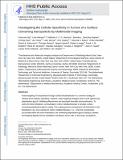Notice
This is not the latest version of this item. The latest version can be found at:https://dspace.mit.edu/handle/1721.1/134578.2
Investigating the Cellular Specificity in Tumors of a Surface-Converting Nanoparticle by Multimodal Imaging
Author(s)
Fay, Francois; Hansen, Line; Hectors, Stefanie JCG; Sanchez-Gaytan, Brenda L; Zhao, Yiming; Tang, Jun; Munitz, Jazz; Alaarg, Amr; Braza, Mounia S; Gianella, Anita; Aaronson, Stuart A; Reiner, Thomas; Kjems, Jørgen; Langer, Robert; Hoeben, Freek JM; Janssen, Henk M; Calcagno, Claudia; Strijkers, Gustav J; Fayad, Zahi A; Pérez-Medina, Carlos; Mulder, Willem JM; ... Show more Show less
DownloadAccepted version (1.363Mb)
Terms of use
Metadata
Show full item recordAbstract
© 2017 American Chemical Society. Active targeting of nanoparticles through surface functionalization is a common strategy to enhance tumor delivery specificity. However, active targeting strategies tend to work against long polyethylene glycol's shielding effectiveness and associated favorable pharmacokinetics. To overcome these limitations, we developed a matrix metalloproteinase-2 sensitive surface-converting polyethylene glycol coating. This coating prevents nanoparticle-cell interaction in the bloodstream, but, once exposed to matrix metalloproteinase-2, i.e., when the nanoparticles accumulate within the tumor interstitium, the converting polyethylene glycol coating is cleaved, and targeting ligands become available for binding to tumor cells. In this study, we applied a comprehensive multimodal imaging strategy involving optical, nuclear, and magnetic resonance imaging methods to evaluate this coating approach in a breast tumor mouse model. The data obtained revealed that this surface-converting coating enhances the nanoparticle's blood half-life and tumor accumulation and ultimately results in improved tumor-cell targeting. Our results show that this enzyme-specific surface-converting coating ensures a high cell-targeting specificity without compromising favorable nanoparticle pharmacokinetics.
Date issued
2017Journal
Bioconjugate Chemistry
Publisher
American Chemical Society (ACS)